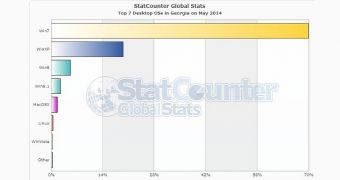They say that Windows is losing users, mostly because of the growing market share posted by Linux lately, but statistics provided by market researchers across the world have always claimed otherwise.
While there's no doubt that a handful of users have indeed moved to Linux in the last couple of years, it's pretty clear that Windows continues to rule the desktop world everywhere around the globe and things are very unlikely to change anytime soon.
Statistics provided by StatCounter demonstrate that there are countries where Windows is currently installed on more than 97 percent of local PCs, which does nothing more than to confirm the domination of Microsoft's operating system in the PC industry.
Let's take Georgia as an example. StatCounter says that at this point 69.97 percent of the desktop computers in the country are powered by Windows 7. Nothing surprising here given that Windows 7 is also the number one platform all over the globe.
Windows XP comes second with a share of 19.58 percent, followed by Windows 8 with 5.19 percent, and Windows 8.1 with 2.5 percent.
Overall, Windows has a market share in Georgia of no less than 97.24 percent, without even counting the number of PCs running less-popular versions of Windows, such as Vista or Windows 2000.
If it does any difference, it's worth mentioning that Mac OS X is currently holding a share of 1.64 percent in Georgia, while Linux is now powering 0.41 percent of the PCs in the country.
There's no doubt that Microsoft must be happy with such figures, but the chart is a little bit different in other countries across the globe. In most of the cases, Windows 7 is indeed number one, followed by Windows XP and Windows 8.1, but both Mac OS X and Linux usually have bigger shares.
In the meantime Microsoft is struggling to make Windows a much more popular platform in the tablet industry as well, trying to promote Surface tablets and devices built by partners as much as possible. At the same time, it also adjusted Windows 8.1 hardware requirements and even lowered the price of its operating system in order to allow more manufacturers to install it on their devices.
A free SKU of Windows 8.1 called Windows 8.1 with Bing is now available for OEMs that are building cheap tablets in an attempt to bring more affordable devices to the market.

 14 DAY TRIAL //
14 DAY TRIAL //